I've been lost in a Super Famicom fugue these past few months, but I've finally found my way back to the PC Engine to continue the work I began at the start of the year (and earlier, if I'm being technical). Feels kinda redundant to begin each of these Wiki Project rundowns with the same few paragraphs of exposition, so here's a few refreshers to get you up to speed on what the PC Engine is and the type of games we've seen on this system before now: Turbo Time (HuCard), Legend of the PC Engine '89 & Legend of the PC Engine '90.
1991 was an interesting year for the PC Engine overall, though hardly a positive one. The system was battered by both the NES and the Genesis in its lifespan, despite some moderate success in its home nation and its innovative CD-based format which would eventually become the de facto standard for video game consoles for the following generation (well, besides portable systems and the stubborn N64). 1991 saw one more competitor take a large slice of the home console market: the Super Famicom, our old friend, which debuted in Japan right at the end of 1990. The PC Engine's HuCard output,, which was already getting marginalized by its CD successor, saw only forty-four releases total in that year. Certainly makes it easier for a wiki project like this, at least.
Just to recap the specifics here, if not the whole spiel about Hudson and NEC's console: this Wiki Project only covers games released exclusively in Japan on the HuCard cartridge format. The reason being is that previous Wiki Projects have already fully investigated the North American TurboGrafx-16's entire HuCard library (see above), and CD-format games require a lot more finesse to properly extract screenshots and the like. I'll get around to it eventually.
What follows are a list of ten games I consider to be the most "interesting" released during this period, as well as another list of ten well-regarded and/or better known games, many have been released on other systems in North America and PAL territories, that could well have shifted some stock had they seen an international release. I'm sure there's more than enough valid reasons why those releases never came to be, but all the same the TurboGrafx-16 sorely could've used more games.
Top Ten "Interesting" Games
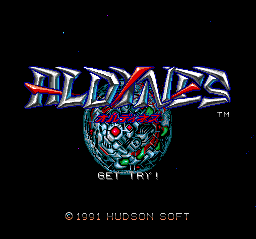 | Aldynes: Quick recap on the SuperGrafx, since it's important here: the SuperGrafx is to the PC Engine/TurboGrafx what the PS4 Pro is to the PS4 - a slightly more powerful system built to accommodate and potentially enhance the games you already have, as well as a handful of games that would only really work on the improved hardware. The Pro (and XB1 Scorpio, come to think of it) doesn't quite fit the latter, but I think we all suspect that Pro/Scorpio-only games might come if the install base is big enough. That was the SuperGrafx's issue: it started producing games for the system before they could convince anyone to shell out for a slightly better PC Engine, even though they'd already shelled out for the CD peripheral. Aldynes was one of three games unique to the platform - there were seven total, but four were Arcade conversions - and designed to be a shoot 'em up that would show off the SuperGrafx's enhanced parallax scrolling, which was very close to what the Genesis, SNES and Arcade could pull off in 1991. It ended up being a game no-one bought for a system no-one bought, despite its caliber. (2/22/1991.) |
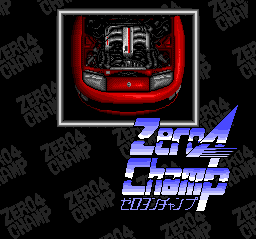 | Zero-4 Champ: The Zero-4 series, which began with this entry, marked two big divergences from the racing game norm. The first was how it focused entirely on 400m drag races, which took away a lot of what normally makes a racing game click - how you handle turns, the diversity of the course geography - and instead doubled down on player reflexes when gear shifting (there's no auto transmission) and vehicle customization. The second divergence was how it introduced a more elaborate storyline than most games of its genre, presenting a rags-to-riches story about a young gearhead trying to win fame and wealth through illegal street racing, with various seedy characters and dramatic turns along the way. Though one could argue how much influence it actually has, it could be seen as an early pioneer for what became a prevalence of driving games that tie together its set-pieces with a story about making it big in some kind of illegal street racing scene. (3/8/1991.) |
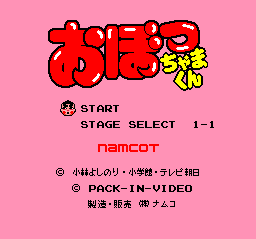 | Obocchama-kun: I feel that, when perusing a Japanese video game console's library for games that fit a qualifier as ambiguous as "interesting", there's a certain flavor that collectors and peripheral fans of Japanese games tend to seek out. I would define it as a very bizarre and intrinsically Japanese personality. Obocchama-kun, a middling platformer based on an obscure gag manga and anime about an obnoxious and oblivious rich kid - think Richie Rich, but without any semblance of altruism - does at least bring the Japanese crazy, referencing a dozen sight gags from its manga and its anime adaptation. This actually translates to some interesting ideas too, as various button combinations can produce a multitude of results, some of which are of more use than others. A goof where Obocchama-kun transforms into a giant peach a la Momotaro is also an enhanced jump, operating in a way similar to the crouch-to-charge super jumps of Super Mario Bros. 2. Most licensed games feel like an excuse to shoehorn a popular character and their foibles into a generic platformer, but at least this one tries. It's not great, but it tries. (3/15/1991.) |
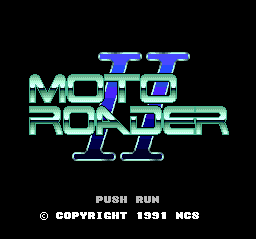 | Moto Roader II: I only bring up this top-down racer because it and its predecessor did what Micro Machines would find great success doing before the toyline racer ever came out. Moto Roader II adds a new curious wrinkle with its inclusion of different vehicle types - a hoverbike that could clear over obstacles and other racers and a tank that would plow through them, but both were harder to turn than the regular car. There weren't a whole lot of racing games to go full sci-fi back then. Still aren't, really. (3/29/1991.) |
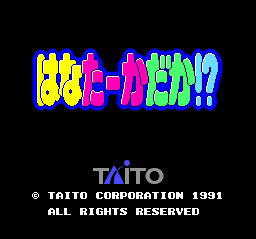 | Hana Taaka Daka!?: I think people have a certain idea about what the TurboGrafx-16 in particular was all about, and to a lesser extent its far busier PC Engine equivalent. It's a mixture of cute-looking side-scrolling platformers like Bonk and fast-paced shoot 'em ups like Blazing Lazers and the Star Soldier games. Naturally, it follows that the system has its fair share of cutesy shoot 'em ups too, like those pioneered by the likes of Konami's TwinBee or Sega's Fantasy Zone. Hanata-Kadaka is one of these; a goofy horizontal shoot 'em up featuring a long-nosed tengu (like the boss of Dead or Alive 2) and a bunch of cartoonish youkai enemies to blast through. I'd liken it to a version of Pocky & Rocky that was more of a standard horizontal shoot 'em up. Writing this as I am just days away from the launch of Yo-Kai Watch 2 in North America, I'd say the repurposing of Japan's mythological monsters in a cute and wholesome way for the sake of kid-friendly video games is a time-honored tradition that continues to this day. (8/9/1991.) |
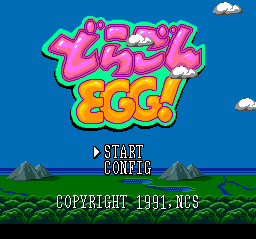 | Dragon EGG!: Another cute platformer, Dragon Egg stood out for its combination of Wonder Boy style platforming with a very mild RPG element, and the conservation of power-ups that is often key to the shoot 'em up genre. The player's dragon companion continues to grow as the player moves around each stage, collecting little growth power-ups to feed it. At later levels of development, this dragon greatly changes how the player approaches the game, giving them higher jumps and a greater amount of firepower to use against their foes. However, it all goes away the instant the player loses a life, so while the game gets easier with a stronger dragon, it's also conversely very difficult because of that harsh penalty for death. I'd liken it to Volgarr the Viking - that game's nominally easier when your bearded hero has an invincible shield and a flaming blade, but it's all too easy to lose either if you get careless. (9/27/1991.) |
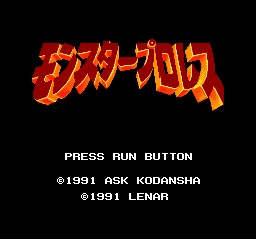 | Monster Pro Wrestling: While certainly not a good game, Monster Pro Wrestling is at least entertaining and very distinct from anything else going on at the time. Adopting a sort of luck-based combat system that is determined by dice rolls and the player's stats - not too dissimilar from old school RPGs - the player's mutant wrestler and his opponent are given a few seconds to spam the attack button to reconfigure the balance of power in their favor before a canned animation plays out based on a secondary roll that determines what type of move the wrestler will perform. The game is fairly hands off but for this button-mashing charge, and the player's only major contribution is distributing the new stat bonuses after each bout. It's a ridiculous and limited game, but a distinctive one. (11/22/1991.) |
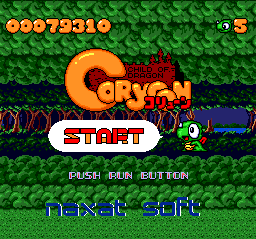 | Coryoon: Coryoon is another example of a cutesy shoot 'em up, one of a large number for the system. It's also one of several games in this and the following list that has you play as a dragon, or at least with a dragon accompaniment. The game begins with a weird premise: an evil wizard demon shows up and transforms the hero's princess friend into... a smaller, chibi princess. This sort of disrespect towards royalty won't stand, and Coryoon flies into action. The game adopts what was becoming a frequent power-up system where subsequent power-ups of the same color would lead to stronger variations, while collecting a separate color put you back at square one. You'd also lose any power-ups you had if you got hit, serving as a lifeline in a manner similar to Sonic's rings. Last was Coryoon's powerful charge attack, which only requires that the player stops shooting for a few seconds. If nothing else, the game had some ideas to go with its colorful presentation. (11/29/1991.) |
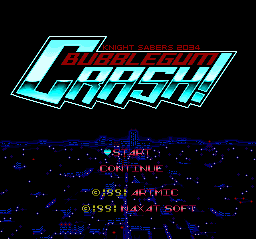 | Bubblegum Crash: Along with its predecessor series Bubblegum Crisis, Bubblegum Crash was one of the more popular animes of the late-80s and early 90s, to the extent that it was part of the first batch of OVAs - original video animations, which bridge the gap between serial TV and movies in both application and runtime - to see localizations for the West. The anime, and the game, concern a near-future Tokyo devastated by an earthquake some years prior that split it into two entities, corporations with too much power who create biomechanical humanoids by the hundreds which all too frequently fall into the wrong hands, and a team of highly skilled exosuited female mercenaries who step in whenever the beleaguered police are unable to help. Even so, the license didn't get much play in the video game world. The only two examples I'm aware of include a PC-88 game called Crime Wave and this game, which is a story-driven graphic adventure that alternates its protagonist between the four main heroines of the series. I couldn't get too far into it given its large amount of Japanese text, but there are translation guides out there. (12/6/1991.) |
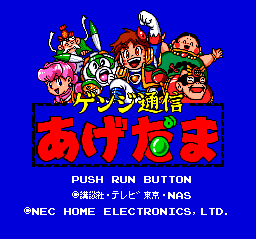 | Genji Tsuushin Agedama: Another anime license, one that liberally borrows and parodies a lot of existing tokusatsu and sentai shows, Genji Agedama is an animated series sees the eponymous youth transform into an armored hero whenever the need arises. The game is fairly distinct for combining an endless runner with a shoot 'em up - in a sense, the game auto-scrolls like a shoot 'em up would, and the player is very reliant on a series of power-ups to ensure they can win the battles of attrition against the many foes they face. However, the game still has the hero on-foot, so there are occasions when the player needs to complete some platforming sequences to avoid damage. Most of Agedama's power-ups add extra levels to his charge up attack, each more powerful than the last, so players are often best served building up as full a gauge as they can manage and clear the screen with the resulting blast. (12/13/1991.) |
The "Why Was This Not a Thing" Round-Up
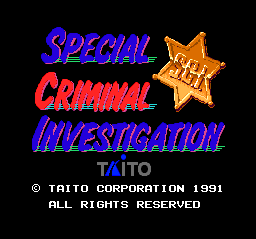 | S.C.I.: Special Criminal Investigation: As in, Chase HQ 2. It doesn't add much to the original game's blueprint of driving into a perp's car a lot until it bursts on fire, though it does now also let your partner shoot at them from the sunroof. Either way, Taito could've shifted a number of copies of this in North America, where cops shooting at bad guys along busy highways is a far more common sight. (I mean in movies and stuff. Jeez.) (1/25/1991.) |
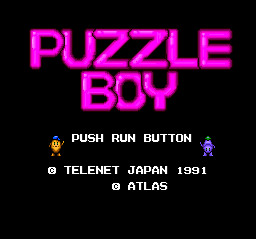 | Puzzle Boy: While not the hottest seller in a very busy marketplace for puzzle games, Kwirk for the Game Boy at least did well enough to be a recognizable name amidst the Tetrises and Dr Marios and I think a full-color console adaptation would've done as well as the NES Tetris/Dr Mario adaptations. If nothing else, having the larger screen would've been more conducive when clearing the bigger rooms. If you've not encountered Kwirk before, it's a puzzle game where you have to push pieces around to create a path to the exit, combining the likes of Sokoban/Boxxle with a maze game. (2/22/1991.) |
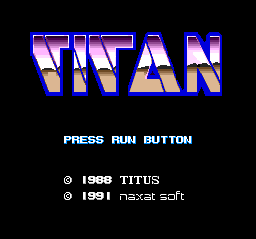 | TITAN: TITAN's one of a handful of European computer games - in this case originally developed by France's Titus Interactive for various home computers popular on the continent - that saw a Japanese console adaptation that never left Japan. Given the TurboGrafx-16 never actually saw a European release, barring a few limited runs in very specific regions, it's perhaps fair enough that their games weren't deemed tenable to localize in the States. Even so, there's not a whole lot of challenging nuance to this top-down variant of Breakout to stump language barriers, and weirder stuff managed to cross over just fine. (3/15/1991.) |
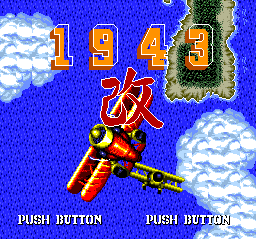 | 1943 Kai: Capcom's WW2 vertical shoot 'em up 1942 and its sequels were popular enough on other systems, and the PC Engine's 1943 Kai - which reimagines the original 1943 with more lasers and other anachronisms - wasn't an exception, though critics tended to rate it lower than its forebears. For the longest time, this particular variation on 1943 remained Japan-only - it wasn't until the various Arcade-perfect Capcom compilations in the PS2 era that North America and Europe would get to try it out. (3/22/1991.) |
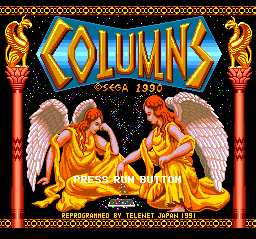 | Columns: We've spoken before in previous "Why Wasn't This a Thing?" round-ups that certain Sega titles like the antiquity-themed match-3 puzzle game Columns were jealously guarded by Sega in territories other than Japan, so while Columns saw both a PC Engine and a Super Famicom port in its native land us folk overseas had to settle for the Genesis version. It might also have something to do with its status as a Genesis pack-in game for some regions, which increased its value as an exclusive. (3/29/1991.) |
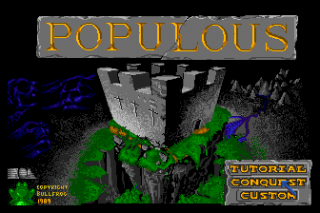 | Populous: Peter Molyneux and Bullfrog's own original God-sim was another European home computer game to receive a PC Engine port. The game uses a specific type of tech to expand the original system's resolution to better fit the entirety of the game's isometric UI, so maybe that has something to do with its lack of a localization. HuCards didn't really have space to include fancy enhancement chips the way that NES and SNES carts did, though, so I'm not entirely sure how this was done. (4/5/1991.) |
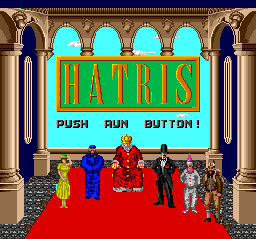 | Hatris: Hatris was a moderate success on the Nintendo Entertainment System, where it garnered both ironic and genuine appreciation for its unusual premise of building stacks of hats on unsuspecting haberdashery customers. The PC Engine mixed things up by introducing new heads every round, though I haven't play the NES version enough to remark on all the differences with any authority. Either way, it's the sort of silly puzzle game that can add some personality to a console, and being designed by Tetris's creator Alexey Pajitnov would've helped its sales pitch anywhere. (5/24/1991.) |
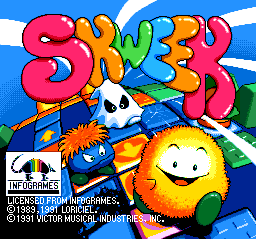 | Skweek: Skweek is the European version of Q*Bert, building an action game around painting every tile on the level a specific color, and yet another example of a European home computer game that was recreated by a Japanese team for a region-exclusive audience. There is one extra wrinkle in this case, however, in that this exact version was later adapted for the Sega Game Gear as well, and that version did see an international release under the name of Slider. Little reason why its console sibling couldn't also make the journey. (8/2/1991.) |
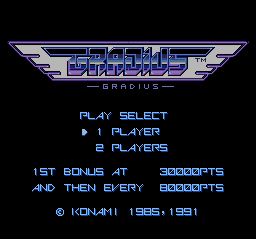 | Gradius: Probably goes without saying why Gradius, Konami's best-known shoot 'em up, should've seen releases in more territories when it came out on the PC Engine. For one, it was one of the better Arcade conversions of the game out there, which is probably why it was chosen to be part of the Wii's Virtual Console over its lacking NES port. I mean, it's Gradius. Why didn't Konami think they could sell a better-looking home version of Gradius overseas? It's not like it ever saw a Genesis or SNES version (though the SNES did get Gradius III around this time). (11/15/1991.) |
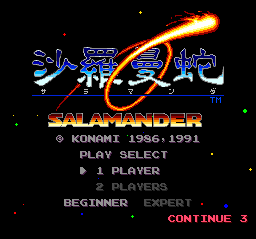 | Salamander: Likewise, Salamander - or Life Force, as it was known in the US - is a Gradius semi-sequel, semi-spin-off that did well enough on the NES. This version isn't quite as gooey as its visceral NES port, having been based on the original Japanese Arcade version rather than the modified version that leaned hard on the organic aesthetic that the NES saw (and Japan would later receive in a weird bit of recursion), but that just adds to the game's distinctiveness in the US game market. "You've played the NES spin, now try an Arcade-close version of the Japanese original on our system!". All right, fine, I guess as marketing taglines go it could use some polish. (12/6/1991.) |
Anyway, that's going to do it for this update. I'm going to combine the next three years - 1992, 1993 and 1994 - for the next Wiki Project round-up because even with all three years joined together it's still a very small amount of releases. The PC Engine was on the way out at this time, CD and HuCard platforms alike, and besides the occasional late aberration like Motteke Tamago in 1997 or Dead of the Brain 1&2 in 1999, its release schedule more or less dries up in the mid-90s. If it couldn't compete with the SNES and Genesis, it sure as heck didn't stand much of a chance against the PlayStation.
Still, though, it's often the case that the greatest games for any given console are those released late in its life cycle, where multi-year projects finally conclude and developers have become savvy enough to wring every last drop of processing and graphical power from the console, so let's hope we see a few worthy swansongs next time. See you then.
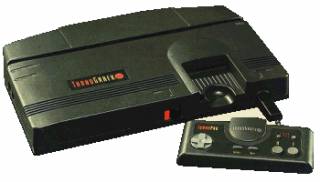
Log in to comment